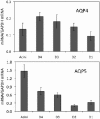Changes of the ocular surface and aquaporins in the lacrimal glands of rabbits during pregnancy
- PMID: 22128232
- PMCID: PMC3224838
Changes of the ocular surface and aquaporins in the lacrimal glands of rabbits during pregnancy
Abstract
Purpose: To test the hypotheses that pregnancy represents a physiologic condition that is associated with dry eye symptoms, and the expression of aquaporin 4 (AQP4) and AQP5 are altered in the lacrimal gland (LG) from term pregnant rabbits.
Methods: Schirmer's test, tear break-up time (BUT), and Rose Bengal staining were used to evaluate ocular surface health. LG were obtained from term pregnant rabbits and age-matched female control rabbits and then processed for laser capture microdissection (LCM), real time RT-PCR, western blot, and immunofluorescence for the detection and quantification of mRNA and proteins of AQP4 and AQP5.
Results: Pregnant rabbits demonstrated typical clinical symptoms of dry eye, including decreased Schirmer score and BUT as well as increased Rose Bengal staining of cornea. In term pregnant rabbits, mRNA for AQP5 from whole LG was significantly lower than that of control rabbits, while mRNA for AQP4 was not. Levels of mRNA for AQP4 and AQP5 underwent significant changes in acini and epithelial cells from specific duct segments during pregnancy. Western blot from whole LG lysates demonstrated that expression of AQP4 was 24% more abundant in term pregnant rabbits while AQP5 was 22% less when compared to control rabbits respectively. At term pregnancy, AQP4 immunoreactivity (AQP4-IR) was increased in acini while its intensity remained the same in ducts. AQP5-IR was present in both apical and basolateral membranes of acinar cells in normal control and pregnant rabbits, while ductal cells in pregnant rabbits also showed significant amount of AQP5-IR.
Conclusions: The data presented here demonstrated significant dry eye symptoms in pregnant rabbits. Our data also showed altered expressions of AQP4 and AQP5 during pregnancy and suggested that these changes may contribute to the altered LG secretion and dry eye symptoms during pregnancy.
Figures








Similar articles
-
Na(+)/K(+)-ATPase expression changes in the rabbit lacrimal glands during pregnancy.Curr Eye Res. 2013 Jan;38(1):18-26. doi: 10.3109/02713683.2012.725797. Epub 2012 Sep 25. Curr Eye Res. 2013. PMID: 23009595 Free PMC article.
-
Changes of aquaporins in the lacrimal glands of a rabbit model of Sjögren's syndrome.Curr Eye Res. 2011 Jun;36(6):571-8. doi: 10.3109/02713683.2011.574330. Epub 2011 Apr 27. Curr Eye Res. 2011. PMID: 21524183 Free PMC article.
-
Tear Production After Bilateral Main Lacrimal Gland Resection in Rabbits.Invest Ophthalmol Vis Sci. 2015 Dec;56(13):7774-83. doi: 10.1167/iovs.15-17550. Invest Ophthalmol Vis Sci. 2015. PMID: 26641554
-
Is the main lacrimal gland indispensable? Contributions of the corneal and conjunctival epithelia.Surv Ophthalmol. 2016 Sep-Oct;61(5):616-27. doi: 10.1016/j.survophthal.2016.02.006. Epub 2016 Mar 9. Surv Ophthalmol. 2016. PMID: 26968256 Review.
-
Research in dry eye: report of the Research Subcommittee of the International Dry Eye WorkShop (2007).Ocul Surf. 2007 Apr;5(2):179-93. doi: 10.1016/s1542-0124(12)70086-1. Ocul Surf. 2007. PMID: 17508121 Review.
Cited by
-
The Role of Aquaporin 4 in Lacrimal Gland Ductal Fluid Secretion in Mice.Invest Ophthalmol Vis Sci. 2024 May 1;65(5):30. doi: 10.1167/iovs.65.5.30. Invest Ophthalmol Vis Sci. 2024. PMID: 38771571 Free PMC article.
-
ENaC in the Rabbit Lacrimal Gland and its Changes During Sjögren Syndrome and Pregnancy.Eye Contact Lens. 2015 Sep;41(5):297-303. doi: 10.1097/ICL.0000000000000123. Eye Contact Lens. 2015. PMID: 25828511 Free PMC article.
-
Altered mucins and aquaporins indicate dry eye outcome in patients undergoing Vitreo-retinal surgery.PLoS One. 2020 May 21;15(5):e0233517. doi: 10.1371/journal.pone.0233517. eCollection 2020. PLoS One. 2020. PMID: 32437405 Free PMC article.
-
Na(+)/K(+)-ATPase expression changes in the rabbit lacrimal glands during pregnancy.Curr Eye Res. 2013 Jan;38(1):18-26. doi: 10.3109/02713683.2012.725797. Epub 2012 Sep 25. Curr Eye Res. 2013. PMID: 23009595 Free PMC article.
-
The Sustained Effects on Tear Volume of Pilocarpine Hydrochloride in Gelatin by Hydrogel Administered by An Implant-mediated Drug Delivery System.Curr Drug Deliv. 2017;14(4):581-586. doi: 10.2174/1567201813666161013150648. Curr Drug Deliv. 2017. PMID: 27739377 Free PMC article.
References
-
- Pflugfelder SC, Tseng S, Sanabria O, Kell H, Garcia C, Felix C, Feuer W, Reis B. Evaluation of subjective assessments and objective diagnostic tests for diagnosing tear-film disorders known to cause ocular irritation. Cornea. 1998;17:38–56. - PubMed
-
- Wong J, Ding C, Yiu S, Smith R, Goodwin T, Schechter JE. An Epidemiological Study of Pregnancy and Dry Eye. Ocul Surf. 2004;3:S127.
-
- Sullivan DA. Tearful relationships? Sex, hormones, the lacrimal gland, and aqueous-deficient dry eye. Ocul Surf. 2004;2:92–123. - PubMed
-
- Ding C, Chang N, Fong YC, Wang Y, Trousdale MD, Mircheff AK, Schechter JE. Interacting Influences of Pregnancy and Corneal Injury on Rabbit Lacrimal Gland Immunoarchitecture and Function. Invest Ophthalmol Vis Sci. 2006;47:1368–75. - PubMed
Publication types
MeSH terms
Substances
Grants and funding
LinkOut - more resources
Full Text Sources
Medical
